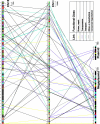Genome sequence of the radioresistant bacterium Deinococcus radiodurans R1
- PMID: 10567266
- PMCID: PMC4147723
- DOI: 10.1126/science.286.5444.1571
Genome sequence of the radioresistant bacterium Deinococcus radiodurans R1
Abstract
The complete genome sequence of the radiation-resistant bacterium Deinococcus radiodurans R1 is composed of two chromosomes (2,648,638 and 412,348 base pairs), a megaplasmid (177,466 base pairs), and a small plasmid (45,704 base pairs), yielding a total genome of 3,284, 156 base pairs. Multiple components distributed on the chromosomes and megaplasmid that contribute to the ability of D. radiodurans to survive under conditions of starvation, oxidative stress, and high amounts of DNA damage were identified. Deinococcus radiodurans represents an organism in which all systems for DNA repair, DNA damage export, desiccation and starvation recovery, and genetic redundancy are present in one cell.
Figures


References
-
- Anderson A, Nordan H, Cain R, Parrish G, Duggan D. Food Technology. 1956;10:575–578.
-
- Masters CI, Murray RG, Moseley BE, Minton KW. J Gen Microbiol. 1991;137:1459–69. - PubMed
- Counsell TJ, Murray RGE. Int J Syst Bacteriol. 1986;36:202.
-
- Minton KW. Mol Microbiol. 1994;13:9. - PubMed
-
- Battista JR. Annu Rev Microbiol. 1997;51:203. - PubMed
Publication types
MeSH terms
Substances
Associated data
- Actions
- Actions
- Actions
- Actions
- Actions
- Actions
- Actions
- Actions
- Actions
- Actions
- Actions
- Actions
- Actions
- Actions
- Actions
- Actions
- Actions
- Actions
- Actions
- Actions
- Actions
- Actions
- Actions
- Actions
- Actions
- Actions
- Actions
- Actions
- Actions
- Actions
Grants and funding
LinkOut - more resources
Full Text Sources
Other Literature Sources
Molecular Biology Databases

